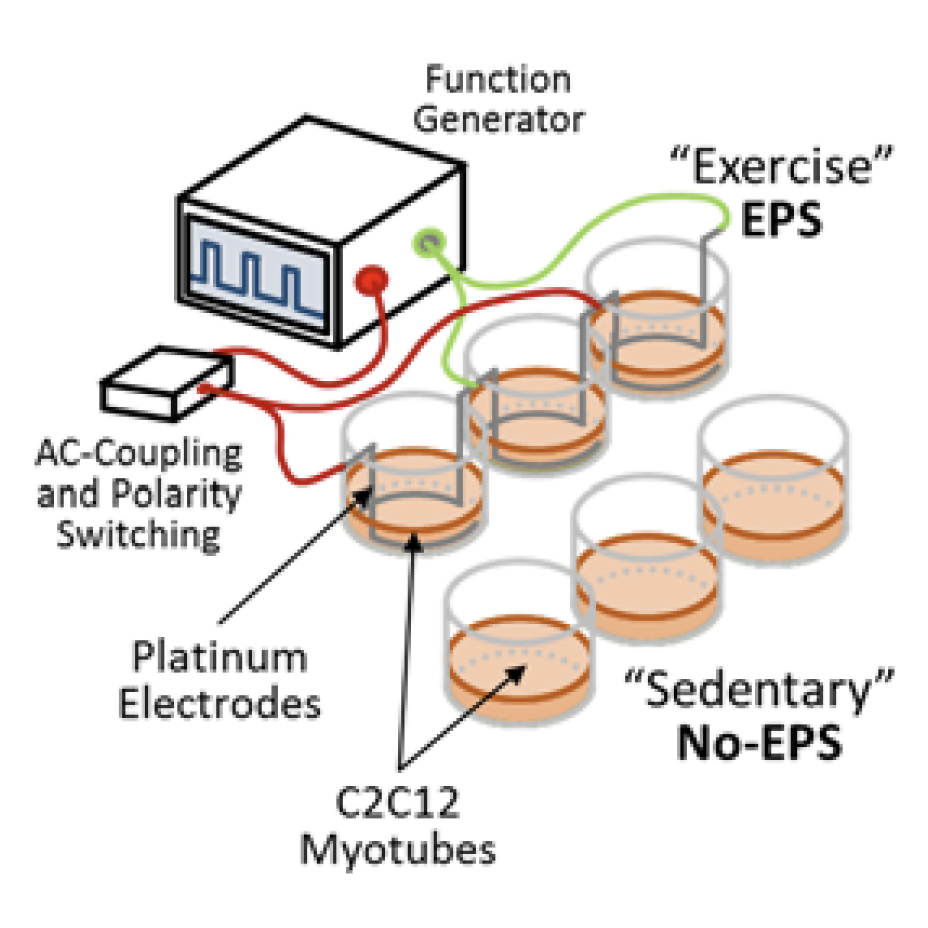“Exercise-in-a-pill” Encapsulates Power and Promise of Biomedical Research
January 18, 2022
Researchers at LSU’s Pennington Biomedical Research Center (PBRC) are mapping the effects of exercise to be able to deliver many of its benefits to those who can’t, or struggle to, work out. The researchers have already shown how something they call “exercise-in-a-pill” could help protect people against the negative health consequences of eating too much sugar and fat.

Exercise has myriad positive effects, including decreased inflammation, lowered blood sugar, and increased liver and pancreatic function (improved insulin secretion). Researchers at LSU’s Pennington Biomedical Research Center have been able to artificially induce many of these positive effects by isolating messenger proteins from contracting muscle (the common denominator of exercise) and applying them to different tissues and organs. In the future, these same messenger proteins could potentially be delivered in the form of a pill, allowing people to reap many of the benefits of exercise without having to move.
– LSU
Baton Rouge—Louisiana ranks fourth in the nation for obesity and diabetes. The human cost of these diseases is immeasurable, and their economic burden—medical costs and lost productivity—is estimated in billions of dollars each year. But what if there was a pill you could take each day that would prevent your blood sugar from going up and the fat you eat from being stored in your body? This could one day be possible, according to researchers in the Integrative Physiology and Molecular Medicine (IPMM) Laboratory at PBRC, who are working toward a new treatment they describe as “exercise-in-a-pill.”
“There are more benefits to regular exercise than we can even begin to understand,” said Christopher Axelrod, an exercise physiologist and director of PBRC’s IPMM lab, which is focused on studying and solving metabolic diseases, such as obesity and diabetes. “This line of research stems from the idea that if we knew which factors produced during exercise made people healthier, then maybe we could isolate them and just give them as a medical therapy. In essence, we will be able to “exercise” people without them having to do the work. Wouldn’t that be revolutionary?”
Axelrod and his team are laying the groundwork. They’ve built an in vitro system to study muscle contraction, which is a core feature and common denominator for all types of exercise. Only for the last 20 years or so have scientists understood that skeletal muscle (muscle attached to bone) is more than a mechanical tool for movement operated by the brain. Instead, skeletal muscle is one of the body’s largest endocrine organs, which means it sends out messages in the form of proteins, called myokines. These messages are like small snippets of code or instructions that tell other parts of the body what’s up, and what to do. But they can be very difficult to isolate and track. Once myokines enter the vascular system, the body’s communication highway, it’s anyone’s guess where they came from and where they’re going. Studying them is like trying to research residential patterns in a major city, but the only tool at your disposal is a traffic camera during rush hour.
“In essence, we will be able to ‘exercise’ people without them having to do the work. Wouldn’t that be revolutionary?”
Christopher Axelrod, director of PBRC’s Integrative Physiology and Molecular Medicine Laboratory
“The human body is a black box, still, in many ways,” Axelrod said. “Things are secreted into your blood from somewhere and then taken up by organs from the blood, so it’s really difficult to say conclusively where things are coming from and where they’re going.”

Human skeletal muscle isn’t “dumb,” simply moving our limbs around as ordered by our brain. On the contrary, skeletal muscle is one of the body’s largest endocrine organs, which means it sends out messages in the form of proteins, called myokines. By using electricity to artificially contract muscle cells in petri dishes in a lab, LSU researchers are decoding the messages, learning how exercised muscle “talks” with other parts of the body to cause a cascade of beneficial responses.
– PBRC/LSU
To solve this problem, the researchers developed “exercise-in-a-petri-dish.” One of the main contributors to this work was Stephan Nieuwoudt, a former trainee of John Kirwan, principal investigator for research in the IPMM lab and executive director of PBRC. Nieuwoudt now works as a research and development director at a biomedical startup called Neuronoff. By isolating muscle cells in a petri dish and making them contract using electricity, the researchers were able to assay the fluid outside of the cells to identify various myokines. After that, they could apply the fluid to any other type of cell (pancreatic, hepatic, adipose, etc.) to see what would happen and learn more about how muscle “talks” with other organs.
In an additional experiment, Nieuwoudt and colleagues bathed the cells in fat and discovered that “exercise-in-a-petri-dish” can provide dramatic protection from the toxic effects of excess fat.
“This was a really promising discovery that provided proof-of-concept that our system recapitulated the effects of exercise in humans,” Kirwan said.
In Louisiana, where poor health rankings are largely driven by obesity and related chronic health problems, a treatment that could deliver some of the benefits of exercise could make a big difference, according to Dr. Eboni Price-Haywood, who is a physician at Ochsner’s Primary Care and Wellness Center in New Orleans.
“Increasing access to physiological benefits of exercise (...) through medications would undoubtedly help improve the overall health of Louisiana.”
Dr. Eboni Price-Haywood, physician at Ochsner’s Primary Care and Wellness Center in New Orleans
“While lifestyle modifications such as increased physical activity is the mainstay of clinical recommendations for treatment, some community members suffer from chronic conditions that prevent them from exercising regularly,” Dr. Price-Haywood said. “Increasing access to physiological benefits of exercise for these individuals through medications would undoubtedly help improve the overall health of Louisiana.”

Metabolic diseases, such as obesity and diabetes, are great health challenges in Louisiana. People who suffer from these diseases are often helped by a change in lifestyle, including exercise, while some have chronic health conditions that prevent them from exercising regularly. Ochsner physician Dr. Eboni Price-Haywood sees great potential in helping them gain access to the physiological benefits of exercise through medications.
– Ochsner
Dr. Price-Haywood is careful to point out, however, that physical activity should remain the go-to treatment for anyone who is able to exercise on a regular basis, given the numerous, well-established benefits, including stress reduction, improved mental health, sharper mental focus, better quality of sleep, enhanced balance and coordination, stronger bones and muscles, and reduced risk of dying from the leading causes of death, such as heart disease and some cancers.
Since one of the main goals of Pennington Biomedical’s IPMM Laboratory is finding new treatments and a potential cure for diabetes—another huge health challenge in Louisiana—Axelrod’s team became particularly interested in the communication between exercised muscle and the pancreas, which secretes insulin to lower sugar, or glucose, in the blood. There are two kinds of diabetes: type 1, usually developed in adolescence or young adulthood, when the pancreas suddenly stops producing insulin; and type 2, when the pancreas eventually tires of producing large amounts of insulin to compensate for extra fat and sugar in the blood. More than 90% of patients with diabetes have type 2. Exercise is known to improve both insulin sensitivity and production, but scientists are only starting to understand how it works.
Since exercise is a systemic event, its effects are complex and interconnected. Axelrod has no illusions about “exercise-in-a-pill” being able to recapitulate all of the beneficial effects of physical movement, such as increased strength and stress relief. The changes his team has observed take place on a chemical and molecular (micro) level, rather than a physical or mechanical (macro) level. However, the potential of any new treatment to help in the fight against the devastating impacts of obesity and diabetes is exciting, Axelrod argued.
“We know that most people don’t exercise regularly for lots of different reasons,” Axelrod said. “There are physical limitations, including muscular deficiencies and impairments, as well as mental and temporal limitations that make exercise impossible or unpalatable on a day-to-day basis. You might have a heart condition that prevents you from doing it, and meanwhile, you desperately need the benefits of exercise. So, the idea of being able to provide that, by giving people an exercise replacement, is revolutionary.”
Read more:
In vitro contraction protects against palmitate-induced insulin resistance in C2C12 myotubes (American Journal of Physiology)
Study Discovers BAM15 as a Potential Treatment for Obesity (PBRC)
To help solve the obesity epidemic by 2040, Pennington Biomedical Research Foundation recently launched a public health advocacy campaign, called Obecity, USA.
PBRC is a member of MoTrPAC, the Molecular Transducers of Physical Activity Consortium, which is funded by the National Institutes of Health to advance research on how physical activity improves health and prevents disease